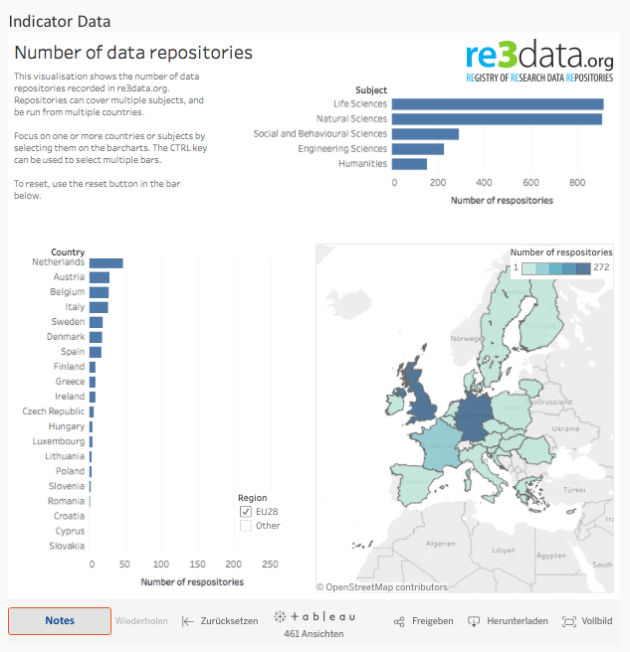Der „Open Science Monitor“ der EU-Kommission ist online. Auszug aus der Beschreibung des Tools zum Monitoring von Open Science in Europa:
„The Open Science Monitor supports open science initiatives in Europe. It provides a way to assess developments in open science and particularly trends in open science activities over time and comparatively between countries and scientific disciplines. […] The monitor was commissioned by the European Commission Directorate-General for Research and Innovation. It was developed by several partners, led by RAND Europe with the support of Digital Science, Altmetric, figshare and Deloitte.“
Für den Bereich „Open Research Data“ werden Daten von re3data verwendet:

Eine ausführliche Darstellung der Methodik findet sich auf der Website des Monitors (PDF). Der Monitor greift auf folgende Quellen zu: 101innovations, Altmetric, arXiv, bioRxiv, Clarivate Analytics, F1000Research, figshare, GenBank, Helmholtz-Centre for Environmental Research – UFZ and German Centre for Integrative Biodiversity Research (iDiv), Nature Publishing Group and Palgrave Macmillan, OpenAIRE, PeerJ preprints, Publons, re3data.org, RePEc, SHERPA/RoMEO, SHERPA/JULIET, Taylor & Francis und Wiley. In Zukunft sollen weitere Quellen, z. B. zur offenen Zugänglichmachung von wissenschaftlicher Software und Open Educational Resources integriert werden.
 Passend zum Thema Metriken für Open Science hat heute die „Expert Group on Altmetrics“, die die Generaldirektion Forschung und Innovation der EU-Kommission berät, ihren Abschussbericht unter dem Titel „Next-generation metrics: Responsible metrics and evaluation for open science“ veröffentlicht.
Passend zum Thema Metriken für Open Science hat heute die „Expert Group on Altmetrics“, die die Generaldirektion Forschung und Innovation der EU-Kommission berät, ihren Abschussbericht unter dem Titel „Next-generation metrics: Responsible metrics and evaluation for open science“ veröffentlicht.
Die fünf Kernaussagen des lesenswerten Reports lauten: „An open science system should be grounded in a mix of expert judgement, quantitative and qualitative measures“; „Transparency and accuracy are crucial“; „Make better use of existing metrics for open science“;“Next generation metrics should be underpinned by an open, transparent and linked data infrastructure;“ sowie „Measure what matters“. Damit wird ein deutlicher Kurswechsel bei der Evaluierung von Forschungsleistung vorgeschlagen.
Die Expertinnen und Experten der Arbeitsgruppe empfehlen auch den Standard ORCID zur Identifikation von Autorinnen und Autoren und weiteren Beteiligten im Forschungsprozess verpflichtend im kommenden Rahmenprogramm für Forschung und Innovation (FP9) zu verankern.
Disclosure: Ich bin in zwei der genannten Initiativen involviert: re3data und ORCID DE.
Zur Methodik bei Open Access zu Publikationen habe ich dicke Fragezeichen. Wenn ich es richtig verstehe, steht im Zähler die Artikelzahl in OpenAIRE, im Nenner die Artikelzahl im WoS. Das eine hat mit dem anderen überhaupt nichts zu tun: WoS ist global, OpenAIRE Europa-zentriert (und hier nochmals mit starkem Fokus auf EU-Förderung). OpenAIRE hat Artikel aus allen Zeitschriften, WoS nur aus den 12.000, die WoS referenziert. Oder verstehe ich das falsch?
The data presented here are based on two sources: OpenAIRE and Clarivate Analytics.
Numerator data were provided by OpenAIRE (as at 5 October 2016). OpenAIRE is an EU-funded project tracking open access across Europe by linking to publication repositories, data repositories, journal repositories and current research information systems (CRIS). It has information from 807 data sources worldwide, including 611 repositories in Europe. OpenAIRE is primarily focussed on Europe and the data is therefore more complete for Europe than for other parts of the world.
Data were aggregated by OpenAIRE data source type. Gold open access data sources include journals and journal aggregators. Green open access data sources include publication repositories (thematic, institutional and other) and publication repository aggregators.
Note: This definition of green open access includes PubMed Central (PMC) data. As a result, the values of green open access are higher than similar analyses of green open access data because the dataset combines author self-archived publications as well as PMC data which are not necessarily author self-archived (for comparison)
Publications in hybrid journals (i.e. journals with some open and some closed access articles) are not generally covered by any of the sources in OpenAIRE.
Publications are counted by data source type and country, and then aggregated. For institutional repositories, publications are counted by country; if publications are deposited in two different countries they are counted twice.
Denominator data were provided by Clarivate Analytics (as at 12 December 2016) from the Web of Science (WoS). WoS is a database of publications covering a wide range of countries and subjects. The data are counts of articles in WoS. There is no double counting of these data.
„The monitor was commissioned by the European Commission Directorate-General for Research and Innovation. It was developed by several partners, led by RAND Europe …“
Wieso wurde die Rüstungsfirma RAND damit beauftragt? Können sich Einrichtungen, die eine Zivilklausel eingeführt haben, wegen dieser Verbindung überhaupt beteiligen?
An open science project is a great idea! In fact, we are currently working on an alternative scientific journals and are still in the process of defining what it could actually look like. We would be honored if you could participate or just leave your thoughts.
https://conocto.com/action/